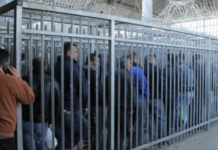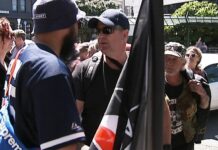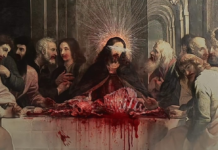And the sign said, “The words of the prophets are written on the subway walls
And tenement halls”
─ Paul Simon, The Sound of Silence 1963-64
BOMBER’S RIGHT about Adam Curtis’s latest offering, Can’t Get You Out of My Head, it is brilliant. You can tell it’s a work of genius by the way it leaves you looking at the world through its maker’s eyes. Just as I can never see at a sunflower without thinking of Vincent Van Gough, or take in a mega-city by night without recalling the first scene of Bladerunner, I will never again be able to see a couple dancing cheek-to-cheek without thinking of Adam Curtis.
And like Adam Curtis. This morning, for example, out with my family for a leisurely Level 3 Lockdown promenade, I encountered an unfamiliar tag, spray-painted on just about every available flat surface between my front door and the park.
“TRAZE STATIC.CA”
What did it mean? Why was it there? Who was its audience?
These questions were certainly not unanswerable. For a start, tags don’t have to “mean” anything. When we see a dog cock his hind leg and urinate on a power pole, we are not inclined to question the meaning of his behaviour. We understand immediately that the animal is simultaneously identifying itself and registering its presence to all the other dogs in the area. It has no more meaning than the nod of recognition I just gave to the couple passing our little group on the footpath. Just a simple mammalian gesture signalling “nothing to fear from us”.
Where does Adam Curtis come into all this? He intrudes by prompting the sort of questions that make his documentaries so riveting. What has led so many mostly young human-beings to mimic the behaviour of dogs? A tag may not have a unique olfactory signature, but its distinctive visual shape and style is intended to convey exactly the same messages: “I was here” and “I am here”.
Now, readers of a certain age will immediately recall the “Kilroy was here” graffito which first began to appear on the walls of European cities during and immediately after World War II. An Anglo-American meme, by all accounts, the image of the lugubrious observer started popping-up wherever American military personnel ventured. From the soon-to-be-vaporised infrastructure of the Bikini Atoll A-Bomb test-site, to the blasted walls of Vietnam, “Kilroy” bore silent witness to the tragedy and absurdity of human conflict.

The difference between the “Kilroy was here” meme and the tagger’s message is, of course, that the latter has absolutely no interest in communicating anything beyond the existence of its creator. Kilroy, by contrast, was a shared identity: one available to everyone who had participated in the overwhelming experiences of combat. For many World War II veterans, talking about what they had seen and done was often extremely difficult. But, Kilroy knew what had happened. He had seen it all. Kilroy had been there.
What, then, is signified by this contemporary retreat from genuine communication? How and why was the mass audience for graffiti shrunk down to these tiny communities of taggers? To handfuls of practitioners who, alone, are capable of recognising the signatures of their fellow scribblers. When did graffiti cease to be a proclamation aimed at anyone who could read, and become instead an arcane collection of secret symbols, intelligible only to the cognoscenti of the spray-can and the magic marker?
In Curtis’s documentary, the older style of graffiti figures prominently. Those who wrote on walls in the decades following World War II were generally communicating messages the “mainstream media” of the day would point-blank refuse to print or broadcast. By slapping up their slogans for all-and-sundry to read they were announcing the existence of alternative interpretations of social, economic and political reality. What their paintbrushes and spray-cans were saying was very simple: the official version is not the only version.

Now, I know what you’re thinking: “Daft old Boomer. Hasn’t he heard of the Internet? Why would anyone risk being done for wilful damage when they can say everything they want to say on Instagram, Twitter and Facebook without recourse to messy paintbrushes and spray-cans? Who needs “Kilroy” when far more powerful memes are just a few judicious keystrokes and mouse-clicks away? Time and technology have passed these old slogan-daubers by. Wake up Grandpa!”
Fair enough! But questions remain.
Isn’t there a difference between posting and painting? The taggers certainly think so. Risking one’s life and limb (not to mention one’s liberty) to make one’s mark on a surface visible to the whole ‘hood speaks volumes about the courage and resourcefulness of the tagger.
Asserting individual identity by spraying one’s tag all over an inner-city billboard may not carry the political cred’ attached to spray-painting “Stop the Tour” across a motorway overbridge, but it remains an impressive achievement nonetheless. Preaching to the Twitter choir about this, that and the other, just isn’t the same. No one is surprised. No one is challenged. So may posts – my own included – strike me as little more than long-winded tags.
Adam Curtis would introduce a talking head about here: someone to draw out the all-too-obvious moral of the tale. That our world is increasingly driven by an intense hunger for individual recognition and acclaim. In a deeply dispiriting way “speaking truth to power” has become a harmless ritual. Not least because power is, almost certainly, not listening. Tweets, Instagram captions, Facebook posts – all have become mere snowflakes in the “blizzard of the world” that the late Leonard Cohen warned us, way back in 1992, was threatening to cross our thresholds and “overturn the order of the soul”.
Daubing up graffiti was an act of faith in the power of collective understanding. When the old man who lived in the narrow brick house on Dunedin’s Great King Street painted the words “Free Latvia!” on his traffic-facing wall, he was not only appealing for the drivers’ political support, he was also announcing his own faith in his homeland’s future. Back in the 1970s, when I was a student, hardly anyone knew what or where Latvia was. We took in the graffiti with youthful bemusement. But the old man’s faith was not misplaced. With the fall of the Soviet Union, Latvia did indeed become free. And those of us who remembered the old man’s impassioned graffiti, smiled.
The last time I was in Dunedin, I noticed how much the paint had faded. I also noted the crude palimpsest of tags which was crawling up the bricks like so much dayglo ivy.
I had no idea what any of it meant.






Traze is a contact tracing app. Static.ca is the website of a Canadian electricity company. I don’t know if that means anything.
What is the meaning of life? while hard to face for some, in a cold, uncaring, quantum universe there is little to none. So our lives become substantially about constructing some meaning.
Graffiti has been chewed over for decades by academics and many large format illustrated books, and how to’s published. It is still a disruptive social form because it exists in the real world, often interrupts private property relations–Vandals! Defaced! It is a pre digital media yet now linked to the internet. From monochrome one liners, to signatures, political memes and manifestos ala Banksy, to truly beautiful wall art.
Like your observation Chris “So many posts–my own included–strike me as little more than long-winded tags.”–or even short winded ones in my case, a quick rejoinder dashed off on social media is almost like tagging,–there, take that!
Still remember the classic “old Ponsonby” tag–“land of the wrong white crowd”.
Me neither, Mikesh. Like you, I Googled the components of the tag. Like you, I was none the wiser!
Yeah I’m old skool like you, Trotter. You are not the only one. I like this :
—————–
”When we see a dog cock his hind leg and urinate on a power pole, we are not inclined to question the meaning of his behaviour. We understand immediately that the animal is simultaneously identifying itself and registering its presence to all the other dogs in the area. It has no more meaning than the nod of recognition I just gave to the couple passing our little group on the footpath. Just a simple mammalian gesture signalling “nothing to fear from us”….
————–
B.S.
The wolf is signaling its pack , its loyalty to that pack and its willingness to defend its pack and its territory. Inasmuch as it has more loyalty than the overworked human equivalent who works from the shifting sands of the treacherous disloyalty to which the human species is subject to.
And compared to a wolf pack?,- humans are disgustingly disloyal.
When you look at a small child of 8 to 10 months you do not smile with bared teeth. You do not make loud noises. You do not stare into their eyes which could be misconstrued as a threat. You treat them as puppies. You do not scare them into a corner whereby both human children and puppies can develop negative lifelong complexes,… you cuddle, you avert your gaze unless invited in, you are gentle and you make cooing sounds, and you lick/ kiss and you allow them to come to you.
That is why so many Native Americans saw the wolf as our teachers.
Traditional Lakota/Dakota Sundance Songs 3/6 – YouTube
https://youtu.be/car9pBXHXKQ?t=8
I know I am majoring in minors,…
But here it is again… in this interview by Chief Joseph River Wind…
Chief Joseph RiverWind: ‘That’s What The Old Ones Say’
https://youtu.be/8o4zDNALYZE?t=4
There’s a lot to be gleaned, from such speakers. We would do well to take into consideration what they have to say.
Well, yes, WK, that might well be what the member of a wolf pack is doing. In Three Kings, Auckland, however, wolf packs are rather thin on the ground.
I stand by my original description.
BBC
“Indonesia: Archaeologists find world’s oldest animal cave painting”
https://www.bbc.com/news/world-asia-55657257
And it was of a warty pig !? I immediately thought of an ancient pig muldoon/bill birch clone pig.
45,500 years ago people were trying to convey to others their message, prophesies and beliefs. Or perhaps their simple liking of warty pigs.
I think that’s fucking brilliant.
Ads do the same thing but we don’t get arrested for plonking up a dip shit add where we can’t but look at it which then burrows into the already exhausted amygdala and suddenly you have a new Corolla and a pair of Nikes and you really don’t know why you did that. You only went out for a bottle of clean skin and $20 gas.
Banksy once said of advertising and I paraphrase: If there’s an ad up were we can’t avoid looking at we have the right and moral obligation to deface it.
I know someone who has a signed Banksy print. It’s been valued at over $100 K and they’ve had it professionally framed and they’re hiding it behind the sofa.
Personally, I regard ALL graffiti as art. Whether it’s the tiny toilet cubicle pencil scribble that, after we must lean forward and squint to read it, says ” You are now shitting at a 45 degree angle” or whether it’s a master stroke of ironic brilliance by the wonderful Banksy. Graffiti is human, is original and is tantalisingly fleeting.
I further think that the more graffiti seen the more I know that society’s functioning as it should. A staggering baby of a thing that’s forever evolving. Ask yourself? How much graffiti do you see in North Korea?
Worryingly, I see very little political graffiti in AO/NZ. Its as if our politics is invisible to those who dare to deface.
And it is. Our politics is invisible.
The fact that labour and national are the same thing, just different frocks, and how they go around unnoticed and unchallenged is worrying. The fact that it’s our framers who earn our living yet it’s Auckland and Wellington that enjoys an unstoppable onslaught of money, culture and fancy dandies living on six figures plus entitlements who do little more than give an opinion that they know will be challenged by yet another for no other reason that trying their best to not be noticed is equally worrying. Remember the ‘Life Magazine’ images of the 1929 Wall Street stock market crash? Lawyers, accountants, bankers and investment advisors where the first onto the roads penniless and shoeless with their husbands, wives and kids.
The Daily Blog? Is this graffiti then ? No wonder the gutless cowards at RNZ kicked @ MB off and out.
Very interesting Post @ CT.
The artist is in this grey area where they are not fully integrated whereas decades of humanities degrees filling the ranks of New Zealand would so no they are oppressed and need to be liberated. It sounds deep but it’s not as simple as that. Want to see real oppression take a look at American Indians. The idea is that even if we are doing relatively well materially we will approach a zero level when we lose our humanity where slaves are treated well, they are beaten without leaving marks leaving complete idiots and not so complete idiots.
Latvia was certainly free after the fall of the Soviet Union ..free to march in remembrance of the good old Waffen SS days
https://en.wikipedia.org/wiki/Remembrance_Day_of_the_Latvian_Legionnaires
They still manage a muster
Latvia like all Baltic Nations Post Russian revelation expect for Finland were free countries until 1939 when the Russians marched backed in on a rape, rampage and stealing orgy from the top end of town to the poor buggers at the bottom.
It’s no wonder they greeted the Germans as liberators after what the Russians did and the Russians repeated the same again in 44-45 including the Ukraine. Like the Baltic Nations also greeted the Germans as Liberators and were to pay a heavy price post WW2 at the hands of Russian until the final Ukrainian resistance forces were finally crushed sometime in the mid 50’s.
They’ve never forgotten what the Russians did to their countries, just like the oral & written histories of the Chinese invasions of the SEA countries by the Chinese and thence why these countries treat Russia & China with suspicion.
Sure , sure, and the Jews were just collateral damage
What a lot people don’t know, that Poland was on the verge of becoming a RW Fascist Government (very similar to what has happened over atm) hadn’t the little Austrian corporal come into power and invaded Poland. It’s very likely that the Polish Jews would face another progom or Russia invading Poland as Poland is regarded to be the bastard child of Europe.
Either way Eastern Europe is a festering scab that was going to be unpicked and even today it’s still a festering scab. It’s interesting to read about Russian views towards Poland & East German Nations during the Warsaw Pact decades. Russia didn’t trust the Poles and they were also concerned what would happen to an United Germany had war broking out, would a United Germany would turn around and attack Poland? As even the East Germans hated Poland & Russia breaking up the Eastern German States including Prussia.
Comments are closed.